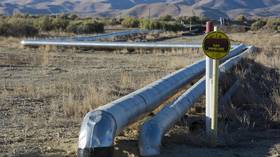The future of US liquefied natural gas hangs in the balance

US liquefied natural gas has the potential to be vital geopolitical tool for the US, and a key part of its energy future, but the emissions associated with the fuel may become a problem.
Soaring American exports of liquefied natural gas (LNG) could become a powerful tool of the Biden Administration to help other countries reduce their carbon footprint from more emission-intensive fossil fuels such as coal, US shale gas producers say.
Moreover, “American natural gas is the sharpest diplomatic tool the Biden administration can wield in energy-related foreign policy and international trade negotiations,” David Callahan, president of the Pittsburgh-based Marcellus Shale Coalition, wrote in InsideSources.com this week.
Also on rt.com World’s largest trade pact led by China could crush US gas exportsHowever, the Biden Administration doesn’t yet have a precise position on natural gas, especially with regards to the domestic energy mix in light of the climate agenda and the ambitions to have 100-percent clean electricity by 2035.
US Secretary of Energy Jennifer Granholm said last week, “We need to get to 100% clean electricity by 2035,” acknowledging this is a very ambitious goal.
Just for reference, natural gas accounted for the largest share of US utility-scale electricity generation in 2020, at 40.3%, with fossil fuels at 60.3-percent share, also due to coal’s 19.3-percent share of the power mix.
Despite the growing global backlash against natural gas and despite its clean energy agenda, the Administration may have to forgo a tough stance on gas, at least in the short and medium-term, with the narrative that American LNG is helping major coal-dependent energy consumers such as China and India to burn a fossil fuel that is cleaner than coal.
In energy-related foreign policy, the Biden Administration is following the Trump Administration’s tough stance toward the Russia-led Nord Stream 2. It has reiterated threats of US sanctions on companies helping Russian giant Gazprom to complete the controversial natural gas pipeline in Europe.
Also on rt.com Despite several packages of US sanctions, Nord Stream 2 pipeline will ‘unequivocally’ be finished in 2021, says Gazprom chairmanAmerican LNG is gaining ground in Eastern European countries like Poland and Lithuania. Those countries are eager to shake off Russia’s dominance over their natural gas supply - and the political clout that comes with it. But Western Europe has started to have second thoughts about imports of US LNG due to the emissions associated with shale gas production. This could potentially undermine the LNG-related diplomacy in western European countries.
In Asia, the world’s main gas demand growth driver, US exports of LNG have been soaring, according to EIA data, and could contribute to the coal-to-gas switch in China and India.
Secretary Granholm said during a confirmation hearing at the Senate Committee on Energy and Natural Resources:
“I believe U.S. LNG exports can have an important role to play in reducing international consumption of fuels that have greater contribution to greenhouse gas emissions.”
Also on rt.com US imports record volumes of Russian oil despite growing political tensionsShe also noted that “If confirmed as Secretary, I also look forward to working with U.S. industry in ways to reduce emissions associated with this commodity.”
The emissions associated with LNG exports have started to become an issue for some buyers, such as France’s utility Engie, which at the end of last year backed out of talks surrounding a long-term US LNG supply deal due to the emissions problem.
Gas demand in China and India is set to continue to increase and offer a growing export market for US LNG exports. Still, in Europe, the green agendas are complicating the role of the fuel in the future.
“Clean energy cannot yet be deployed on the scale needed, fossil gas may still play a role in the transition from coal to zero emission electricity. But I want to be crystal clear with you – fossil fuels have no viable future. That also goes for fossil gas, in the longer run,” Frans Timmermans, Executive Vice-President for the European Green Deal, said last week.
Read more on Oilprice.com: Will 2021 Mark The Start Of A Major Shale Recovery?
The global outlook for gas demand is more robust than that for oil, primarily due to Asian demand.
But in view of the climate agendas and energy transition in developed economies, “Gas players will have to show commitments to decarbonize natural gas, including through carbon capture, utilization and storage (CCUS) and blue hydrogen,” Wood Mackenzie vice president Massimo Di Odoardo said.
US shale gas has a high carbon footprint, and that’s the Achilles heel of American LNG supply, according to WoodMac’s Director of LNG, Giles Farrer.
Also on rt.com Russia joins global hydrogen race with planned exports to Asia“We’re starting to see US producers change behavior, stopping routine flaring and setting targets to reduce methane leakage. But it’ll take years of tighter control – regulation or industry-led – before US upstream gas competes on carbon intensity with global basins,” Farrer said.
America is one of the top three LNG exporters in the world, after Qatar and Australia, but the future of US LNG sales could now depend not only on surging Asian demand but also on buyers’ demand for low-emission cargoes.
This article was originally published on Oilprice.com














